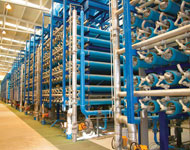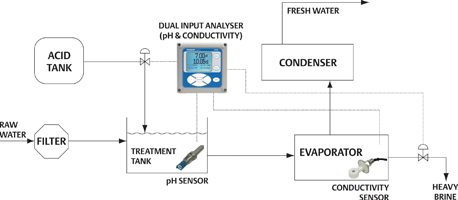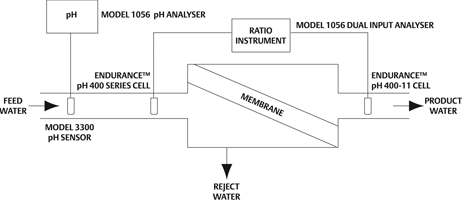
The correct use of analytical instrumentation in thermal and membrane desalination processes maximises plant efficiency and ensures water production costs remain low.
Desalination, the process of removing salt from water, is now used in more than 100 countries and has had a major impact in parts of the world where the lack of fresh water would otherwise limit population growth, as well as industrial and agricultural development.
The synergy with power plants has also helped desalination. Since power plants are often located by the ocean and already have the infrastructure, including extensive piping that draws water into the plant for cooling, it is possible to use these same resources for desalinisation making both applications more cost effective.
There are several methods used for desalination and these are divided into thermal processes including all forms of distillation, and membrane processes including electro-dialysis, nanofiltration and reverse osmosis (RO).

Regardless of which method is used, however, it is extremely important to maximise the efficiency of the plant, increase equipment life and minimise scheduled and unscheduled downtime. Good water chemistry plays a major part in achieving these aims and monitoring good water chemistry relies on the proper use of analytical instrumentation.
Water analysis in thermal processes
Distillation produces nearly half of the world’s desalination water. The process emulates the natural cycle of water with vapour condensing to form fresh water. To perform this process economically, it is essential to reduce the pressure in the boiling vessel below atmospheric pressure as this lowers the boiling point of the water. Reducing the atmospheric pressure on the water being boiled allows multiple boiling of the same water in multiple vessels, each time at a lower pressure and temperature. This reduces the amount of energy required for distillation and increases the yield of fresh water.
Controlling the boiling point of the seawater not only allows multistage boiling but also affects another key issue in desalination – the formation of scale. Substances like carbonates and sulphates are found in seawater and begin to leave the solution when water approaches about 95°C, forming a hard scale. Scale coats any tube or surface creating enormous thermal and mechanical problems in the desalination system. It is difficult to remove so it is important to prevent its formation by controlling the concentration level of the seawater and keeping the temperature and boiling point of the water below that temperature.
In addition, acids are added to the water to remove the scaling compounds such as calcium chloride, magnesium chloride and others that impart hardness to water. Reducing the water hardness helps in boiling the water to the desired temperature thereby increasing the efficiency, but too much acid has the potential to cause corrosion.
Figure 1 shows a typical seawater distillation process. Raw seawater is initially filtered to remove any solids and then is combined with acid in a treatment tank. The treated seawater is heated in an evaporator where much of the scaling can occur. The resulting vapour is collected and recondensed in the condenser as fresh water, and the salt from the seawater is removed as brine.

Two separate scaling problems take place in the evaporator and must be dealt with. The first includes calcium carbonate (limestone) and magnesium hydroxide scale, which are formed under higher pH conditions when bicarbonate ions can form carbonate ions and when hydroxyl (OH) ions are present. Carbonate and hydroxide ions react with the calcium and magnesium normally present in the seawater. Lowering the pH of the feed-water to less than 5,7 minimises calcium carbonate and magnesium hydroxide scaling. Reducing the pH is usually achieved by adding citric acid, ferric chloride or sulphuric acid. However, since too much acid will result in corrosion, the precise pH balance must be maintained with the use of a pH sensor such as Emerson’s Rosemount Analytical line of PERpH-X high performance pH sensors and the Model 1056 dual input intelligent analyser. Typically a pH sensor will be placed in the treatment tank as shown in Figure 1.
A second scale problem occurs when the solution becomes overly saturated with calcium sulphate – roughly 2 grams per litre. Adjusting the pH makes no effect so instead a portion of the heavy brine must be removed from the evaporator. Conductivity is used to monitor the saturation point. Although conductivity does not provide a specific indication of the concentration of calcium sulphate, it does correlate to the level of all dissolved solids. A conductivity sensor with a toroidal design, such as the Rosemount Analytical Model 228, reduces sensor fouling problems in this environment.
Water analysis in RO
The reverse osmosis (RO) desalination method is relatively new and was only commercialised in the 1970s. In the RO process, water from a pressurised saline solution is separated from the dissolved salts by flowing through a water-permeable membrane that is relatively impermeable to dissolved solids. Feed water is pumped into a closed container, against the membrane, to pressurise it. As the product water passes through the membrane, the remaining feed water and brine solution becomes more and more concentrated. To reduce the concentration of dissolved salts remaining, a portion of this concentrated feed water-brine solution is withdrawn from the container. Without this discharge, the concentration of dissolved salts in the feed water would continue to increase, requiring ever-increasing energy to overcome the naturally increased osmotic pressure.
The key factor in reverse osmosis is the condition of the semi permeable membrane, especially since this membrane can represent a considerable capital investment, and frequent replacement is costly and time intensive. The main operational concern related to the use of reverse osmosis units is fouling. Fouling is caused when membrane pores are clogged by salts or obstructed by suspended particulates and it can significantly reduce the success of the desalination operation.
Pre-treatment is important when working with RO. Solids within the water must be removed and the water treated to prevent fouling of the membranes by fine particle or biological growth, and reduce the risk of damage to high-pressure pump components. Pre-treatment usually consists of fine filtration and the addition of sulphuric acid or other acidic solutions. As in distillation systems however, the chemicals cause as many problems as they prevent if not carefully monitored.
Conductivity measurement is used, this time to monitor the efficiency of the RO membrane. The efficiency is calculated by dividing the amount of dissolved solids content of the product water by the volume of the feed water. In a new system this efficiency number could be 2% passage (or 98% rejection). Percent rejection is the difference between the conductivity of the feed water. In time, the efficiency of the membrane will decrease to the point that it must be replaced.
Figure 2 shows the typical placement of conductivity cells. The ‘feed water cell’ is placed on the RO input and a second conductivity cell, called the product cell, is placed on the outlet. A conductivity ratio analyser measures the conductivity of each cell and calculates the percent passage or percent rejection. These analysers are equipped with alarms to monitor the ratio and the product water conductivity, allowing the operators to know when membrane attention is required. General purpose conductivity instruments also provide temperature readings. (Conductivity is a function of temperature, so accurate temperature-corrected conductivity measurement is important.)

The final discharge from an RO desalination plant is a concentrated brine solution. To measure this concentration, plants can again use conductivity to measure the salt concentration of plant discharge in order to meet environmental standards.
Cellulose acetate RO membranes are not recommended for salt-water desalination, but if the feed source is brackish water, a cellulose acetate RO membrane can be used. These membranes tend to be degraded by alkaline (high pH) water, resulting in a loss of efficiency. In feed water with calcium hardness, precipitation (scaling) can occur on the sample side of the membrane in alkaline pH ranges due to the concentration of dissolved solids.
To protect the membrane and avoid scaling, the pH of the feed water can be adjusted to the acid side with a target of pH5.5. The control action is not difficult since the feed water does not typically tend to have a major pH fluctuations or loan changes (changes in the titration curve). Again, a general-purpose pH sensor will assure that pH remains acidic. Placement of the sensor in the feed water stream is shown in Figure 2. To accommodate changes in flow rate, a flow measurement can be used to trim the pH control.
Providing reliable, efficient liquid analytical measurements to assure water quality in desalination systems is relatively easy and extremely cost effective. By simply recognising the critical importance of choosing the right instrumentation and sensors to monitor the appropriate aspects of the desalination process, it is possible to increase plant efficiency and reduce operating costs significantly. These analytical measurements, combined with continued development and improvements in the various desalination treatment methods, will have a significant impact on our ability to provide a future source of safe and reliable drinking water for our growing population and our industrial needs for fresh water.
For more information contact Widad Haddad, Emerson Process Management Dubai, +971 4811 8100, [email protected], www.emersonprocess.com
| Tel: | +27 11 451 3700 |
| Fax: | +27 451 3800 |
| Email: | [email protected] |
| www: | www.emerson.com |
| Articles: | More information and articles about Emerson Automation Solutions |

© Technews Publishing (Pty) Ltd | All Rights Reserved